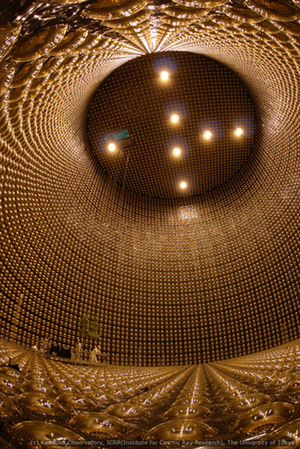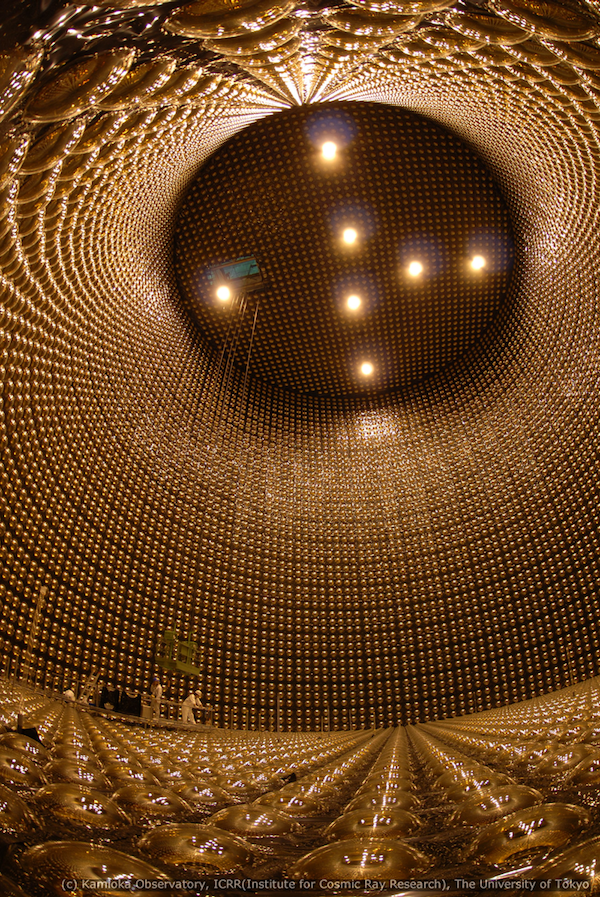Neutrinos Are Brighter at Night
Neutrinos from the Sun change identity as they travel toward the Earth. But the identity change can be reversed, at least a little bit, when solar neutrinos pass through the Earth to reach a detector. An experiment in Japan has now seen indications of this phenomenon by observing a slight difference between the daytime and nighttime detection rates. The results, reported in Physical Review Letters, provide the first hint of direct evidence for a crucial part of neutrino theory. In the future, such observations might also act as probes of the Earth’s interior.
Neutrinos come in three “flavors”––electron, muon, and tau. Nuclear reactions in the Sun’s core produce only electron neutrinos, and these are also the neutrinos to which detectors are most sensitive. On the journey to Earth, mixing between the flavors causes some of the electron neutrinos to change into the other types.
At low energies—around mega-electron-volt ( )—the detection rate of electron neutrinos corresponds to about of the production rate in the Sun’s core. This is consistent with the predicted extent of identity change in the vacuum of space between the Sun and Earth. At higher energies, however, the detection rate drops to about , which is difficult to explain with just vacuum mixing. Theorists have attributed this deficit to neutrinos interacting with dense solar matter on the way from the Sun’s core to its surface. The Mikheyev-Smirnov-Wolfenstein (MSW) effect [1] predicts that higher energy neutrinos will mix more effectively because of the interaction with solar matter, further reducing the number of electron neutrinos. For lower energy neutrinos, the MSW effect is negligible.
The MSW effect explains the solar neutrino data, but it has never been independently verified. “We never see the neutrinos without the intervening solar matter,” explains Andrew Renshaw of the University of California, Irvine. One way to turn the MSW effect “on and off” is to use the Earth as a neutrino filter that rotates in front of a neutrino detector each night. As neutrinos traverse the Earth, the MSW effect causes some of the muon and tau flavors to change back into the electron flavor, increasing the number of electron neutrinos detected. A previous search for the day/night asymmetry saw a very small signal, but it was not statistically significant [2].
Renshaw and his colleagues have now tackled the question with Super-Kamiokande (Super-K), a huge underground neutrino detector in a mine in central Japan. Its -story tank contains tons of water and is lined with photomultiplier tubes. When a high-energy ( – MeV) solar neutrino collides with a water molecule, it can produce a fast-moving charged particle that’s observable through the light it generates inside the tank. Electron neutrinos are times more likely than other neutrinos to produce such an event. But even so, the interactions are so rare that Super-K only detects one or two solar neutrinos per day.
Sifting through years of Super-K data, Renshaw and his collaborators found that the nighttime neutrino detection rate was higher than the daytime rate. The result agrees with theoretical predictions based on neutrino parameters and the Earth’s density profile. The statistical significance of the result is still below the physics community’s threshold for officially claiming a detection, but “we felt it’s important to report these results, rather than wait another years,” Renshaw says.
The finding “is certainly important in order to confirm our understanding of the interaction of neutrinos with matter,” says Gabriel Orebi Gann of the University of California, Berkeley. The Super-K result is not yet a confirmation, “but it’s a very strong hint,” she says. Josh Klein of the University of Pennsylvania thinks it’s “very cool” that we are seeing signs of a quantum-mechanical transformation of neutrinos inside the Earth. Since the transformation depends on the density of the matter interacting with the neutrinos, Klein imagines these observations might one day provide a probe for the interior of the Earth.
–Michael Schirber
Michael Schirber is a Corresponding Editor for Physics Magazine based in Lyon, France.
References
- L. Wolfenstein, “Neutrino Oscillations in Matter,” Phys. Rev. D 17, 2369 (1978); S. P. Mikheyev and A. Yu. Smirnov, “Resonance Enhancement of Oscillations in Matter and Solar Neutrino Spectroscopy,” Sov. J. Nucl. Phys. 42, 913 (1985)
- B. Aharmim et al. (SNO Collaboration), “Combined Analysis of All Three Phases of Solar Neutrino Data from the Sudbury Neutrino Observatory,” Phys. Rev. C 88, 025501 (2013)
More Information
-
Focus: Nobel Focus—Neutrino and X-ray Vision
Focus: Neutrino Models Aren’t Separable
Solving the Mystery of the Missing Neutrinos (a solar neutrino primer by John Bahcall)





